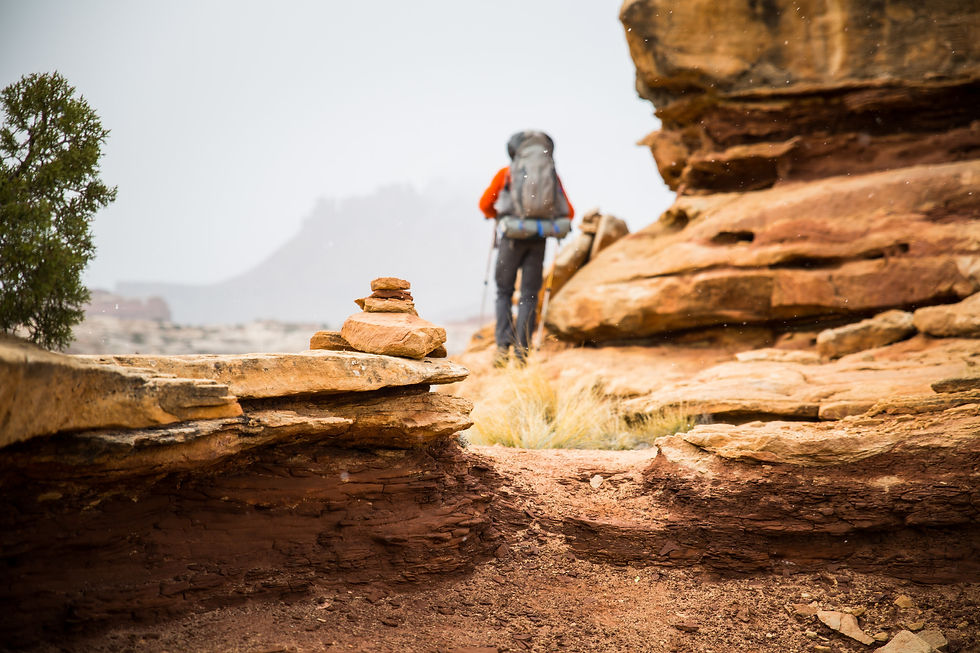On The Trail: What are Rock Cairns?
Maybe you've been out on a trailhead or even out wheeling in your off-road vehicle and you come across what seems to be an confusing but innocent pile of rocks; or is it?

Generally speaking, a "Rock Cairn" are a way of marking the right of way on not-so-well-defined trail. More often or not we see more and more of these rock cairns in places they really shouldn't be and as harmless as it would seem, there's an obvious reason many may miss. So we decided to make a post on our blog to bring light on the purpose of cairns, some of their history, and why to avoid building them for fun on the backroads and backcountry.
Depending on where you might be geo-located in the world, trail markers can and will differ but they all carry similar informational purpose. The "White Blazes", part of a long tradition and history of hiking the Appalachian Trails that mark the route through 14 States. In historic times and still to this day from Maine to the Western Coast, you'll find stacked rocks, known as "cairns" marking many paths and trails. Even more so the further you travel South in the United States you will find even more routes marked with these cairns. In the most simplest form, cairns are stacked rocks in a variety of sizes and even some shapes for specific meanings and purposes. For those most active in the outdoors or with adventure in their veins, the purpose is generally specific to navigation, an outline of a route or trail.

So you may be asking yourself, "why and who used these stacks of rocks to begin with?". It isn't a new idea by any means. Before the advent of the lighthouse, sailors used rock mounds often to support navigational efforts. Stone pile were then and still today very common for marking a route in many parts of the world. One could easily reference back to copies of National geographic books and magazines and take note of many cultures using them in the Tibetan plateau, the Andes Mountains, and Mongolia. Those of which are not only historical and thousands of years old sometimes but sacred to those people.
Now cairns haven't always been used as ancient Google-map uses. All throughout history and again, many cultures across the globe have used them for burial purposes,as a way of defense, marking property lines, borders, and even for the use of hiding a food cache.

Similar in look but certainly distracting in function to cairns is the art or hobby of "rock balancing" where people tend to make abstract towers of rocks in a supposed effort to leave some form of thought to the following people to know someone else was there. What may seem artistic to some actually takes away from the natural beauty of an area.
Cairns are meant for navigational purposes, safety, and for marking trails with the minimal disruption to our natural environments, helping to avoid expensive and unsightly need for signage along trails. The creation of those signs, the implementation of them, along with the need to maintain them time to time is a expansive cost, especially when individuals find it difficult to hold back from vandalizing them.

Leave no trace principles aren't just about trash. Leave no trace means leave no sign that you traveled through the area. That's zero impact. When you move rocks to create decorative cairns you are altering nature for that next visitor and leaving that reminder that you were there.
This is a real problem for those who depend on real rock Cairns for navigational or to mark safe stream crossings.
Generally, rock cairns along trails and in the back country are designated by specific trail creators, park Rangers, or sometimes volunteer trail maintenance. Unless you happen to be one of these people, to avoid confusing accurate trail markers by stacking rocks for fun into cairns in places. Doing so could potentially send hikers in the wrong directions by misinforming them of the right paths.

We hope this clarifies and emphasizes the purpose and importance of rock cairns for navigation.










































